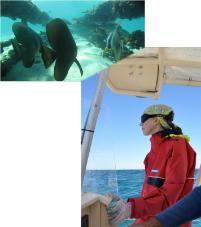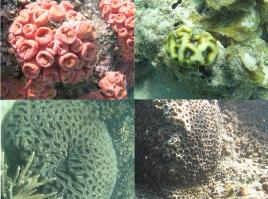Underwater observatory at Keppel has become 'a fantastic fish habitat'
Published on 22 October, 2010
The underwater observatory at Middle Island off Yeppoon and near Great Keppel Island has become a 'fantastic fish habitat', according to a marine researcher who visited the area in October with volunteers checking coral biodiversity.
CQUniversity's Dr Alison Jones said the observatory site "makes for a wonderful snorkel or dive experience, one of the best tourist experiences in the entire region, and as such it should be afforded the utmost protection".

Alison Jones pictured on her way to the reef and an image from her latest dive
She said her team saw "amazing fish life, literally swarms of damselfishes like Chromis nitida (yellow puller or ‘half and halfs' often referred to as trout lolly), Chromis viridis (the bright blue version) and their cousins the Cromis analis (yellow chromis)".
"There were parrotfishes, a humphead parrotfish, massive coral trout, estuary cod, blubber-lipped bream, yellowtail fusiliers, stripeys, surgeonfish, sergeant major fish (striped damselfish), batfish and striped angelfish.
"The only species that I didn't see in numbers were the little brown and cream wire netting cod you normally get there. Perhaps this is because no-one is currently feeding the fish here so they've gone to greener pastures?"
Dr Jones said the fish are amazingly tame and some allow themselves to be patted.
She said the observatory's position in a GBRMPA marine protected area (Green Zone) makes it especially precious to the local region because these fish are protected from fishing and spearfishing and are there for tourists to see when they are snorkeling or diving.

Magnificent corals filmed during the dive
"Aside from fishlife, the corals there are magnificent. There are large Acropora plates growing on the structure itself and massive and sub-massive colonies of corals from the Faviidae family, Porites and azooxanthellate Tubastrea coccinea (which is normally found in caves and under overhangs).
"The top of the walkway block is alive with new coral recruits, small colonies of the extremely rare Acanthastrea bowerbankii and Montastraea species. There is a noticeable lack of the black spiny sea urchins there now and the only two anemones that were there a few years ago have disappeared unfortunately.
"There is a clear sediment-free sandy bottom for divers to rest as well as plenty of crevices and holes for wobbegongs such as the tasseled wobbegong and the sleepy bamboo sharks to hide.
"Behind the observatory lies a wonderful reef slope with thick beds of branching Acropora species: perfect habitat for fish to hide from predators. The shade from the structure probably acts as a reprieve from sunlight in summer for corals, helping them cope with increased temperatures and also provides plenty of spots for fish to hide."
Dr Jones said her team had recorded the coral species at the site and would be returning on a regular basis to teach volunteers how to identify corals through the Head Under Water community monitoring program.
"Although currently still waiting on the Caring for Our Country announcements from the Federal Government, we are hoping to be able to continue with this fantastic program throughout 2011 with more of a focus on teaching about coral diversity and how to identify corals and other marine life," she said.

